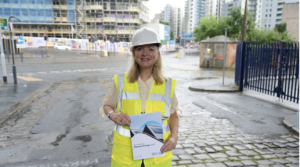Asset-based community development: Restoring the ‘middle ring’
 Asset-based community development restores the civic and neighbourhood connections that have been eroded by technology and mobility, as Cormac Russell, managing director of Nurture Development, explains.
Asset-based community development restores the civic and neighbourhood connections that have been eroded by technology and mobility, as Cormac Russell, managing director of Nurture Development, explains.
‘Well, I… I think that it… that it wasn’t enough to just want to see Uncle Henry and Auntie Em… and it’s that if I ever go looking for my heart’s desire again, I won’t look any further than my own backyard; because if it isn’t there, I never really lost it to begin with.’ Dorothy Gale, Wizard of Oz
In The Vanishing Neighbor, Marc Dunkelman writes about the changes in the social architecture of American neighbourhoods. He notes that adults today relate differently than their grandparents did, tending towards a few intimate relationships (the inner ring) and a wide expanse of more distant surface relationships (the outer ring). The casualties are the relationships in between (the middle ring).
These ‘in between’ relationships are characterised by conviviality and fellowship without intimacy, what the ancient Greeks referred to as ‘philia’, and what we today refer to as civic connections or association. Dunkleman attributes the erosion of the middle-ring to a range of factors including technology, greater mobility, and the growing disconnect with institutions that once mediated the space between civic life and bureaucratic structures.
‘We’ve been empowered in nearly every aspect of our lives to move past many of the burdens that once prevented us from pursuing our personal interests and concerns’, he says.
The seemingly endless pursuit of our ‘true self’ has sought to fill the hollowness of the middle ring and in so doing has further eroded our associational life and ecological stewardship.
Nurture Development was established 21 years ago to support citizens and practitioners to strengthen the ‘middle ring’. Since then our core objective has been to support organisations and communities to redefine what is traditionally meant by the term ‘development’, and terms like ‘helping’, in practice as well as in theory. To do so we have invited organisational changemakers and social activists to adjust some of their traditional co-ordinates.
– Rather than asking, ‘how can we create more value for or with communities?’ we ask, ‘how can we make more space for communities to create what they value?’
Simultaneously we have invited communities, as an alternative to top-down institutionally led change, to consider.
– Instead of asking, ‘how outside agencies can create more value for or with us? To ask, ‘how can we create what we value first using local assets, and then partner with outside agencies to have them appropriately match our assets?’ Thus outside agencies become an extension of community capacities; not a replacement for them.
At the heart of our objective to redefine development and helping approaches has been an approach called asset-based community development (ABCD). Asset-based community development is a description (not a model) of how local residents grow collective efficacy and what they use to do so. The work of ABCD involves paying attention to what is in a local place (what are termed assets); not what we think should be there, or what isn’t there. These assets include:
- The gifts, skills and passions of local residents
- The power of local social networks/associations
- The resources of public, private and non-profit institutions
- The physical and economic resources of local places.
- The stories of our shared lives
Identifying, connecting and mobilising these six assets is a messy and complex endeavour that does not come with a map attached.
Putting ABCD into practice
This process does however come with a set of principles and practices, which act like a compass. ABCD principles and practices are: Citizen-led, relationship-oriented, asset-based, place-based, inclusion-focuse
1. Citizen-led: there are certain things that only citizens, in association with one another, do best. ABCD is focused on this domain of change. From this perspective, socio-political, cultural, environmental and economic change efforts are viewed through the lens of the following questions:
- What is it that residents in communities are best placed to do together?
- What is it that residents can best do, with some outside help?
- What is it that communities need outside agencies to do for them?
2. Relationship-oriented: ABCD goes beyond individuals and their capacities to tap into relational power. Sadly, the power of relationships tends to be undervalued in industrialised societies. Relational power, outside of hierarchical structures such as the workplace, presents an incredible and often untapped force for good. Group behaviour amplifies and multiplies the capacities of individuals, ensuring the societal whole is greater than the sum of its individual parts. Relational power, also referred to as associational life, is a key determinant of:
- individual wellbeing,
- public safety,
- response to natural disasters, and
- vocational opportunities.
3. Asset-based: the starting point for ABCD is ‘what’s strong, not what’s wrong’. Some misunderstand this as an attempt to minimise life’s challenges, or normalise injustices, but nothing could be further from the truth. ABCD is the process by which relational power is mobilised to produce sustainable and satisfying change. Starting with ‘what’s strong’ enables local people to get organised to address what’s wrong and make what’s strong even stronger. It also asks searching questions of those who seek to define certain neighbourhoods by the sum of their deficits.
4. Place-based: Small local places are the stage on which a good, sustainable and satisfying life unfolds. Seeing the neighbourhood as the primary unit of change is a powerful strategy for addressing some of our most intractable socio-political challenges. It is however a strategy that is counter-cultural, in that it seems to contradict those strategies that see individuals or institutions as the most legitimate domains for change. While personal transformation and institutional interventions have their place, we have seen that by intentionally organising relational power at neighbourhood level, local residents can connect local human, associational, environmental, economic and cultural resources together and by aggregating them at a hyper local level come up with solutions which are not within the reach of top down institutions. In over 35 countries around the world we have seen the power of collective action trump the capacities of innovative individuals.
We have also come to recognise that it is only when agencies start organising themselves the way people organise their lives, instead of expecting people to organise their lives the way they have organised their services, that true partnerships between citizens and institutional systems will emerge.
Neighbourhoods, small towns, villages and estates are the scale at which local residents come to believe they can make an impact. This neighbour-to-neighbour impact is not about service provision, but about neighbourliness. A small local place also provides the context within which the multiplicity of helping agencies (each currently working within their own siloes) can agree a common ground that automatically takes them beyond their administrative boundaries. ‘Neighbourhood’ is the potential context within which everything can come together, where relational civic power when needed can join with the power of civic professionals and their institutional resources. In sum, places can exist and thrive without people, but people cannot exist and thrive without places.
5. Inclusion-focused: communities have imperceptible perimeters, inside which are those deemed to belong, and outside which are those considered to be strangers. We are mostly interested in working with local people to support them to create a welcome for the ‘strangers’ at the edge of the multitude of invisible perimeters that exist in every community of place.
In short, the principles and practices of ABCD are about investing in the group life of the neighbourhood, recognising that collective efficacy is measured not by the strengths or capacities of its leaders, but by the power and connectivity of its groups.
Stories from the field:
To bring our work to life allow me to share two examples from our learning sites in the United Kingdom. Nurture Development has supported the establishment of ABCD demonstration throughout the U.K. You can read more about the learning sites:
- Lockleaze, Bristol: A resident in Lockleaze had an idea to offer their neighbours the opportunity to affordably eat out together as a family. Sam – our community development officer – connected her with other residents who were interested in cooking and the idea then grew to become a community supper where people would also learn about the culture and background of the different people in their community. The first Lockleaze Community Supper was held before Christmas 2016 and saw 45 people enjoy foods from and learn about the cultures of Portugal and Jamaica. Denise and Lakisha who organised the first supper along with Sue are now looking forward to holding more suppers with their neighbours throughout 2017 and working with new people they have met as a result of the first event.
(Taken from the Bristol City Council, ABCD online story platform)
- Clayton West, Kirkless: Three local connectors in Clayton West organised what they called an ‘Open House’ for residents in Clayton West, a village in Kirkless. Over 120 people came to share their interests and views on the area. While there, people enjoyed chatting with their neighbours (most of whom they didn’t know before the event) over tea and cake. The purpose was simple, it was about coming together and having fun. During the event people shared their skills and ideas for new groups and activities, e.g. yoga, knitting, singing. This led to an even bigger more ambitious event called ‘Open Village’. The Open Village event took place on 19th September 2015. It consisted on a day and evening of events and activities hosted and run by residents and groups throughout the village of Clayton West. Open Village continues to be supported by Made in Clayton West, which is an open network of local residents. They are connecting people and skills in the village to help make things happen that make Clayton West an even better place to live.
The modern credo asserts that ‘without the marketplace there can be no liberation’, I would like to conclude – with due regard to the above stories and thousands of other ABCD stories like them- by contesting that credo, instead I wish to reaffirm the words of the legendary civil rights activist Audre Lorde ‘Without community, there can be no liberation’.
In the final analysis, solutions to the erosion of the ‘middle ring’ that step lightly on the planet, include everyone and place liberation above diagnosis are proving to be the most sustainable, sufficient and satisfying, which is to say as Dorothy from the Wizard of Oz would have us remember:
‘There’s no place like home’.















